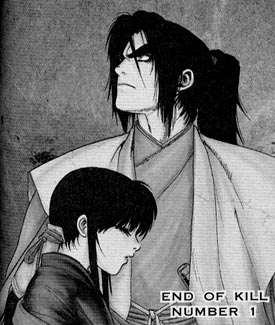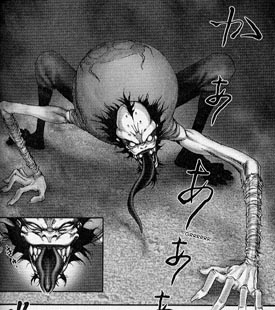 By Masaki Segawa
By Masaki Segawa
Based on a story by Futaro Yamada
208 pages, black and white
Published by Del Rey
Sometimes you hear about how great a series is and all the hype was true; it really is as sharp and interesting as everyone talked it up to be. And then, other times, it not only can’t live up to the hype, it just doesn’t work. Of course, you never really seem to know until it’s almost too late. That, I suppose, is half of the fun.
Two long-feuding ninja clans have been at a tentative-at-best peace thanks to a truce that keep the pair of them from embarking in utter destruction. When the Shogun decides that he needs one of the clans at his disposal, he decides to let the two clans fight in a very special battle, with ten ninjas on each side trying to kill the others. The winners will rule for the next millennium, the losers will have been destroyed. Only not everyone participating even knows that such a competition has truly begun…
 When broken down into a plot description, Basilisk (adapted by Masaki Segawa from a story by Futaro Yamada) sounds pretty exciting. Unfortunately, what this really goes to show is just what a difference there is between a basic plot and the actual execution of the ideas. Basilisk in some ways reminds me of one of those fighting video games like SoulCalibur or Street Fighter where two martial arts opponents fight each other, each using their own unique abilities. When one opponent is destroyed, their remains are shuffled off and a new fighter takes their place. That’s the bulk of Basilisk, with ninjas who know about the battle ambushing those who don’t and beating the crap out of each other. I’m not against the idea of the “competition” comic, where the main point is to see the characters fight each other. The difference is that in books like Naruto (with super-powered ninjas, no less) or Whistle! (really, a sports competition book isn’t that different) it’s interesting because you’re seeing the characters strive to get better and improve their skills against increasingly difficult opponents. In Basilisk it’s more like watching sitting ducks get picked off one at a time, in admittedly creative ways.
When broken down into a plot description, Basilisk (adapted by Masaki Segawa from a story by Futaro Yamada) sounds pretty exciting. Unfortunately, what this really goes to show is just what a difference there is between a basic plot and the actual execution of the ideas. Basilisk in some ways reminds me of one of those fighting video games like SoulCalibur or Street Fighter where two martial arts opponents fight each other, each using their own unique abilities. When one opponent is destroyed, their remains are shuffled off and a new fighter takes their place. That’s the bulk of Basilisk, with ninjas who know about the battle ambushing those who don’t and beating the crap out of each other. I’m not against the idea of the “competition” comic, where the main point is to see the characters fight each other. The difference is that in books like Naruto (with super-powered ninjas, no less) or Whistle! (really, a sports competition book isn’t that different) it’s interesting because you’re seeing the characters strive to get better and improve their skills against increasingly difficult opponents. In Basilisk it’s more like watching sitting ducks get picked off one at a time, in admittedly creative ways.
Now don’t get me wrong, there is another subplot going on, involving a pair of ninja whose love crosses clan lines and how the two plan to marry and thus unite the two clans. It’s a pretty standard idea but it’s the one thing that could save Basilisk, provided it ever shows up for more than a couple of pages. At the end of the first volume most of the characters are still in the dark, including our star-crossed lovers. So their plot is going nowhere fast, and the end result is one of boredom. There’s nothing like the one potential saving grace actually getting more development on the back cover of a book than in the pages itself. (Seriously, the back cover has the character development that Segawa doesn’t manage to bring across in the actual book.) So while there are some pretty neat “how will they kill each other next?” moments, the writing of Basilisk is unappealing at best.
 I’m starting to think that the only reason Basilisk is so loved by readers is Segawa’s art. Segawa draws some truly creepy looking characters, bringing Yamada’s character ideas to life in a glorious over the top fashion. The characters are a stunning combination of human, monster, and superhero; with each of them you never really know just what you’re going to get, from prehensile tongue and bulbous head to inflatable bodies and serpent appendages. They all look wonderfully wrong, though, and Segawa does a great job of bringing across the idea that these are very dangerous beings to be near. I also really liked Segawa’s art style in general. It uses a lot of grey ink washes and shading on the pages, bringing a real sense of unease and darkness to the setting. It’s a great decision for the visuals of Basilisk; while the characters themselves may be underdeveloped, the forest the ninjas fight in has a real personality. Even the characters themselves follow suit, with dark shocks of hair and bushy eyebrows adding to the general lack of light and white space in the comic.
I’m starting to think that the only reason Basilisk is so loved by readers is Segawa’s art. Segawa draws some truly creepy looking characters, bringing Yamada’s character ideas to life in a glorious over the top fashion. The characters are a stunning combination of human, monster, and superhero; with each of them you never really know just what you’re going to get, from prehensile tongue and bulbous head to inflatable bodies and serpent appendages. They all look wonderfully wrong, though, and Segawa does a great job of bringing across the idea that these are very dangerous beings to be near. I also really liked Segawa’s art style in general. It uses a lot of grey ink washes and shading on the pages, bringing a real sense of unease and darkness to the setting. It’s a great decision for the visuals of Basilisk; while the characters themselves may be underdeveloped, the forest the ninjas fight in has a real personality. Even the characters themselves follow suit, with dark shocks of hair and bushy eyebrows adding to the general lack of light and white space in the comic.
I wish I could have liked Basilisk more, and for all I know it improves in future installments. As an opening act, though, it falls horribly flat. It may be awfully pretty look at, but there isn’t anything else there. At least with a new PlayStation or XBox game you get some interactive entertainment in characters mindlessly fighting, but this is more like ending up with a defective copy where you’re stuck with the pre-game teaser playing on an infinite loop. Horribly disappointing, and not recommended unless you’re in it strictly for the art.
Purchase Links:
